Summary - UK Performance Indicators 2004/05
This section summarises the sector-wide information for each of the indicators, and provides a comparison with the sector values from previous years, where appropriate. Indicators for institutions where the number of students with the requisite information is less than 500 tend to be rather variable, and in the following paragraphs are referred to as small institutions.
Percentage from schools and colleges in the state sector
This indicator, shown in table series T1, is produced for young full-time undergraduate entrants. The term ‘State schools or colleges’ is for all schools that are not classed as independent.
Table A gives figures for entrants to first degree courses at institutions in each country and shows comparative values over the past five years. These figures do not take into account any changes in population, or in the pattern of school attendance, over this time.
Table A - Percentage of young entrants to full-time first degree courses from state schools
| 2000/01 | 2001/02 | 2002/03 | 2003/04 | 2004/05 | |
|---|---|---|---|---|---|
| UK | 85.7 | 86.0 | 87.2 | 86.8 | 86.7 |
| England | 85.0 | 85.2 | 86.4 | 86.1 | 85.9 |
| Wales | 90.8 | 90.9 | 91.9 | 91.5 | 91.2 |
| Scotland | 84.0 | 85.0 | 87.5 | 85.9 | 86.3 |
| Northern Ireland | 99.9 | 99.7 | 99.9 | 99.8 | 99.7 |
Sourced from Table T1a of the Performance Indicators.
Nationally, over 90% of 17 year-olds in full-time education attend schools or colleges in the state sector (Source: Department for Education and Skills). 86.7% of young entrants to full-time first degree courses in 2004/05 had attended such schools. Most institutions take more than 90% of their young students from state schools. About one in nine institutions take 70% or less of their young entrants to full-time first degree courses from state schools. Chart 1 shows this pattern.
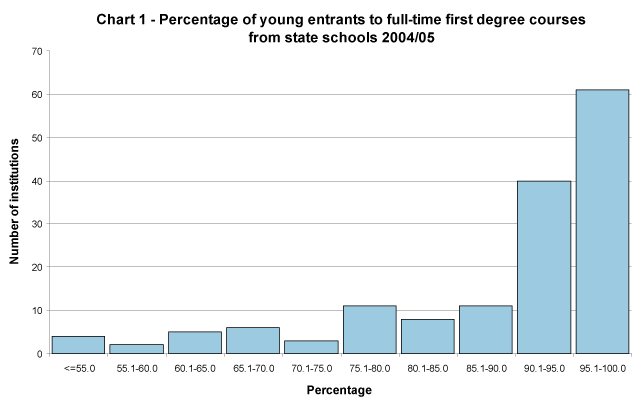
Sourced from Table T1a of the Performance Indicators.
Percentage from NS-SEC Classes 4, 5, 6 and 7
This indicator is produced for young full-time undergraduate entrants to higher education and is also given in table series T1.
This indicator uses categories 4 to 7 of the National Statistics Socio-Economic Classification (NS-SEC) in the 'low SEC' group, with categories 1 to 3 as 'not low SEC'.
Figures based on the Labour Force Survey and quoted in Regional Trends 39 (Source: Office for National Statistics) show that 47% of the population of working age with known classification (excluding NS-SEC class 8, long-term unemployed or never worked) are classified in groups 4 to 7, where classification is based on current or most recent occupation. Nationally, 28.2% of young entrants to full-time first degree courses come from this section of the population.
Table B - Percentage of young entrants to full-time first degree courses from NS-SEC Classes 4, 5, 6 or 7
| NS-SEC classes 4-7 | |||
|---|---|---|---|
| 2002/03 | 2003/04 | 2004/05 | |
| UK | 28.4 | 28.6 | 28.2 |
| England | 27.9 | 28.2 | 27.9 |
| Wales | 29.8 | 29.5 | 28.4 |
| Scotland | 28.0 | 26.9 | 26.7 |
| Northern Ireland | 41.3 | 42.4 | 41.2 |
Sourced from Table T1a of the Performance Indicators.
The percentage from NS-SEC Classes 4, 5, 6 and 7 varies widely between institutions. The spread of values for this indicator is shown in Chart 2.
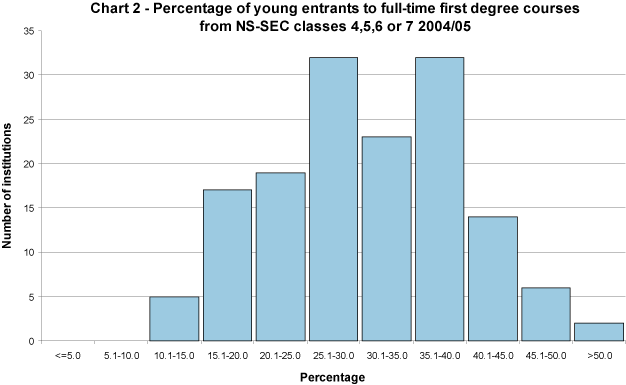
Sourced from Table T1a of the Performance Indicators.
Percentage from low participation neighbourhoods
The percentage of entrants from low participation neighbourhoods is provided separately for young and mature undergraduate entrants, both full-time and part-time. The definition of and further information about low participation neighbourhoods is given in the definitions document.
The indicators given in Table T1a-T1c are for young full-time entrants, Table T2a and T2c for mature full-time entrants and Table T2b for part-time entrants.
Full-time entrants
In the UK as a whole, about 30% of young people live in areas classed as low participation (Source: Higher Education Funding Council for England). 13.7% of young entrants to full-time first degree courses and 14.9% of mature entrants to full-time first degree courses (who also had no previous higher education qualification) came from low participation neighbourhoods. Tables C and D show the percentages for young and mature students for all the countries in the United Kingdom.
Table C - Percentage of young entrants to full-time first degree courses from low participation neighbourhoods
| Young | |||||
|---|---|---|---|---|---|
| 2000/01 | 2001/02 | 2002/03 | 2003/04 | 2004/05 | |
| UK | 12.5 | 13.1 | 13.3 | 13.9 | 13.7 |
| England | 11.8 | 12.4 | 12.5 | 13.3 | 13.1 |
| Wales | 15.0 | 15.0 | 16.0 | 16.7 | 16.8 |
| Scotland | 17.8 | 18.3 | 18.6 | 18.3 | 18.6 |
| Northern Ireland | 9.2 | 9.3 | 10.1 | 10.5 | 9.5 |
Sourced from Table T1a of the Performance Indicators.
Table D - Percentage of mature entrants to full-time first degree courses (who also had no previous higher education qualification) from low participation neighbourhoods
| Mature | |||||
|---|---|---|---|---|---|
| 2000/01 | 2001/02 | 2002/03 | 2003/04 | 2004/05 | |
| UK | 14.0 | 14.1 | 13.8 | 14.5 | 14.9 |
| England | 13.9 | 14.1 | 13.8 | 14.2 | 14.9 |
| Wales | 15.5 | 15.3 | 18.3 | 18.8 | 20.8 |
| Scotland | 13.6 | 13.7 | 11.4 | 14.4 | 12.8 |
| Northern Ireland | 13.1 | 11.9 | 11.4 | 14.4 | 10.8 |
Sourced from Table T2a of the Performance Indicators.
Part-time entrants
There is a difference between young and mature part-time entrants as regards this indicator. 19.2% of young entrants and 8.3% of mature entrants to part-time undergraduate courses come from low participation neighbourhoods.
Tables E and F show the pattern for part-time entrants for the countries of the United Kingdom, and Charts 3 to 6 show the spread across institutions for the indicators between young and mature, and full-time and part-time entrants.
Table E - Percentage of young entrants to part-time undergraduate courses (who also had no previous higher education qualification) from low participation neighbourhoods
| Young | |||||
|---|---|---|---|---|---|
| 2000/01 | 2001/02 | 2002/03 | 2003/04 | 2004/05 | |
| UK | 16.4 | 19.8 | 20.5 | 18.5 | 19.2 |
| England | 15.8 | 19.8 | 17.7 | 17.5 | 17.7 |
| Wales | 22.9 | 32.8 | 34.0 | 25.8 | 26.7 |
| Scotland | 17.0 | 23.2 | 20.4 | 17.8 | 17.0 |
| Northern Ireland | 2.9 | 17.9 | 3.6 | 2.6 | 3.8 |
Sourced from Table T2b of the Performance Indicators.
Table F - Percentage of mature entrants to part-time undergraduate courses (who also had no previous higher education qualification) from low participation neighbourhoods
| Mature | |||||
|---|---|---|---|---|---|
| 2000/01 | 2001/02 | 2002/03 | 2003/04 | 2004/05 | |
| UK | 7.4 | 7.7 | 7.6 | 8.0 | 8.3 |
| England | 7.2 | 7.7 | 7.4 | 7.8 | 8.0 |
| Wales | 13.5 | 12.9 | 13.8 | 12.4 | 14.0 |
| Scotland | 5.4 | 7.6 | 6.5 | 6.7 | 9.4 |
| Northern Ireland | 6.0 | 5.6 | 4.3 | 3.2 | 2.2 |
Sourced from Table T2b of the Performance Indicators.
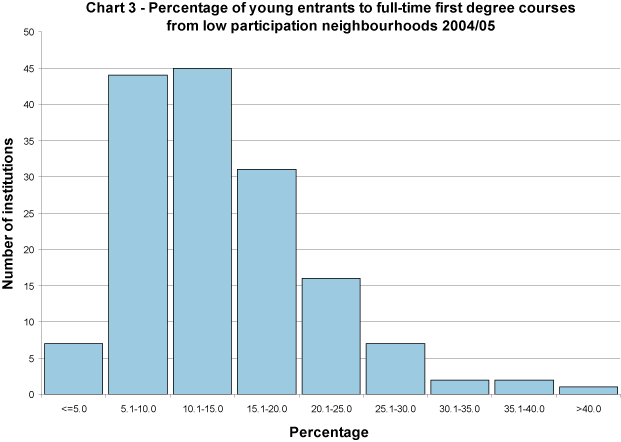
Sourced from Table T1a of the Performance Indicators.
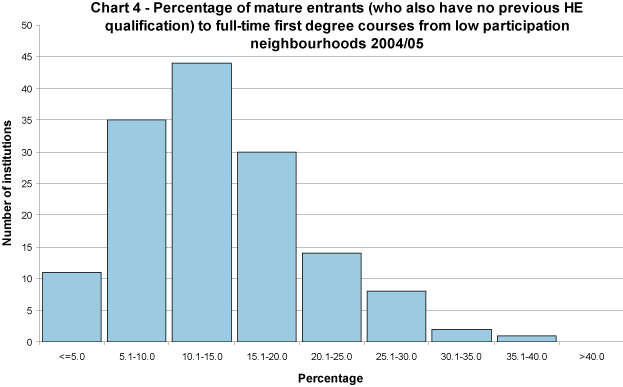
Sourced from Table T2a of the Performance Indicators.
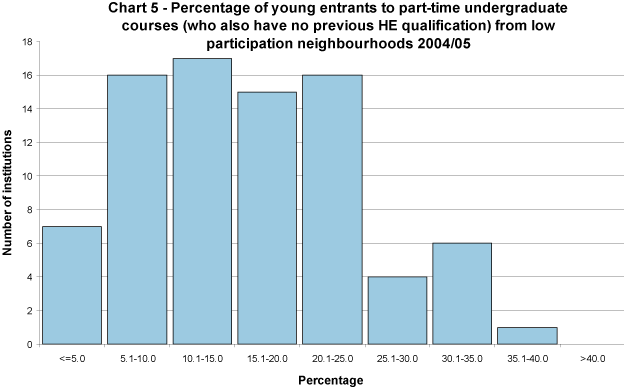
Sourced from Table T2b of the Performance Indicators.
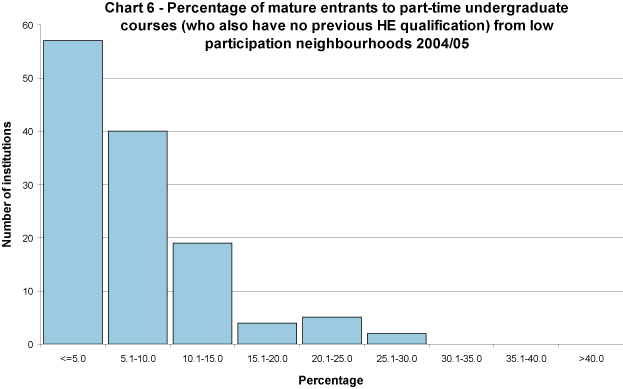
Sourced from Table T2b of the Performance Indicators.
Percentage of disabled students
The indicator, in Table T7, is provided separately for full-time and part-time undergraduates. Unlike the other widening participation indicators, it is based on all undergraduates, not just entrants, because of the small numbers involved. The indicator used is the proportion of students who are in receipt of disabled students' allowance (DSA), as this is more robust than the proportions reporting that they are disabled.
The proportion of students in receipt of DSA is relatively small. The percentage of such students on full-time undergraduate courses in 2004/05 was 3.5% (3.0% in 2003/04), with institutional values ranging from 0.0% to 18.8%.
For part-time undergraduate students, excluding those at the Open University (OU), 1.6% (1.2% in 2003/04) were in receipt of DSA. The OU, with over a third of all eligible part-time students, had 2.4% of its students in receipt of DSA.
Table G shows the equivalent figures for the countries of the UK over a five-year period and Chart 7 shows the spread of values for full-time first degree students.
Table G - Percentage of students in receipt of DSA, for full-time first degree and part-time undergraduate students
| Full-time first degree | Part-time undergraduate | ||||||||||
|---|---|---|---|---|---|---|---|---|---|---|---|
| 2000/01 | 2001/02 | 2002/03 | 2003/04 | 2004/05 | 2000/01 | 2001/02 | 2002/03 | 2003/04 | 2004/05 | ||
| UK (excl. OU) | 1.5 | 2.1 | 2.6 | 3.1 | 3.6 | 0.4 | 0.7 | 0.9 | 1.2 | 1.6 | |
| England (excl. OU) | 1.6 | 2.1 | 2.6 | 3.1 | 3.7 | 0.4 | 0.8 | 0.9 | 1.2 | 1.6 | |
| Wales | 2.0 | 2.9 | 4.0 | 4.4 | 4.7 | 0.5 | 0.7 | 0.9 | 1.3 | 1.7 | |
| Scotland | 1.1 | 1.8 | 2.2 | 2.5 | 3.1 | 0.3 | 0.4 | 0.7 | 1.0 | 1.3 | |
| Northern Ireland | 0.6 | 1.2 | 1.7 | 2.4 | 2.7 | 0.1 | 0.7 | 1.0 | 1.5 | 2.0 | |
| Open University | 4.6 | 1.8 | 1.8 | 2.1 | 2.4 | ||||||
Sourced from Table T7 of the Performance Indicators with the Open University excluded from the totals.
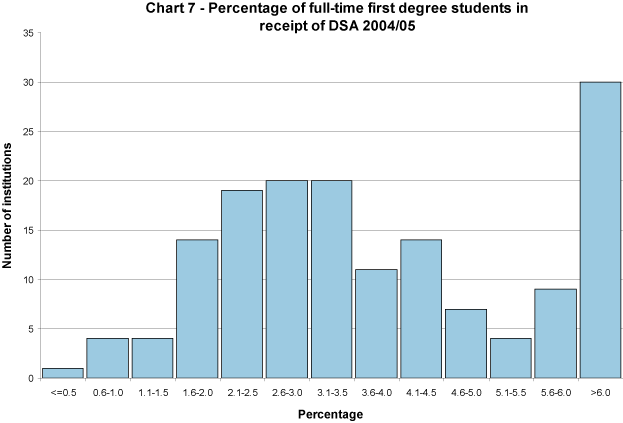
Sourced from Table T7 of the Performance Indicators.
Non-continuation rates after first year at institution
Table series T3 gives this indicator, which shows what proportion of entrants continue in higher education beyond the first year. Table T3a provides this indicator separately for young and mature full-time first degree entrants to higher education.
In general, a higher proportion of mature entrants than young entrants do not continue in higher education after their first year. For entrants in 2003/04, the UK non-continuation rate is 15.6% (15.4% in 2002/03) for mature entrants compared with 7.7% (7.8% in 2002/03) for young entrants. The non-continuation rate for young entrants is 10% or less at 73% of institutions. For mature entrants it is between 2% and 22% at the majority of institutions. However, it is above 20% at around 9% of institutions.
Tables H and I shows the non-continuation rates for the countries of the UK for the last 5 years, for young and mature full-time first degree entrants respectively. Charts 8 and 9 illustrate the spread of values between institutions in 2003/04, again for young and mature full-time first degree entrants respectively.
Table H - Percentage of young full-time first degree entrants not continuing in HE after their first year
| Young entrants | |||||
|---|---|---|---|---|---|
| 1999/2000 | 2000/01 | 2001/02 | 2002/03 | 2003/04 | |
| UK | 7.8 | 7.1 | 7.3 | 7.8 | 7.7 |
| England | 7.7 | 6.9 | 7.0 | 7.3 | 7.2 |
| Wales | 7.3 | 6.9 | 7.2 | 8.0 | 8.5 |
| Scotland | 9.2 | 8.8 | 9.6 | 10.7 | 10.0 |
| Northern Ireland | 7.3 | 7.2 | 9.2 | 9.7 | 11.2 |
Sourced from Table T3a of the Performance Indicators.
Table I - Percentage of mature full-time first degree entrants not continuing in HE after their first year
| Mature entrants | |||||
|---|---|---|---|---|---|
| 1999/2000 | 2000/01 | 2001/02 | 2002/03 | 2003/04 | |
| UK | 15.9 | 14.5 | 14.9 | 15.4 | 15.6 |
| England | 16.0 | 14.4 | 14.8 | 15.1 | 15.4 |
| Wales | 14.9 | 14.3 | 16.5 | 17.2 | 17.2 |
| Scotland | 15.7 | 15.5 | 15.4 | 17.3 | 16.9 |
| Northern Ireland | 11.9 | 10.8 | 10.6 | 11.9 | 12.1 |
Sourced from Table T3a of the Performance Indicators.
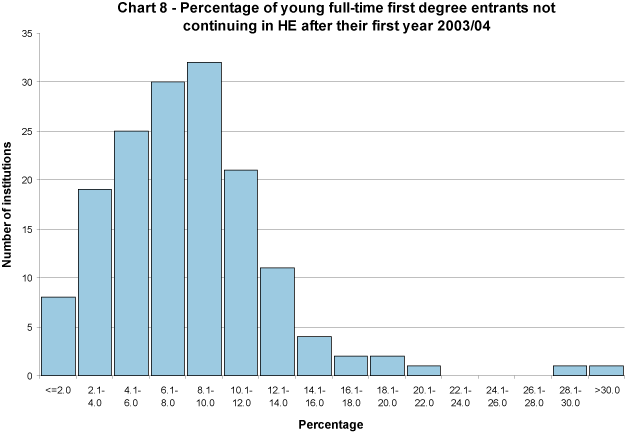
Sourced from Table T3a of the Performance Indicators.
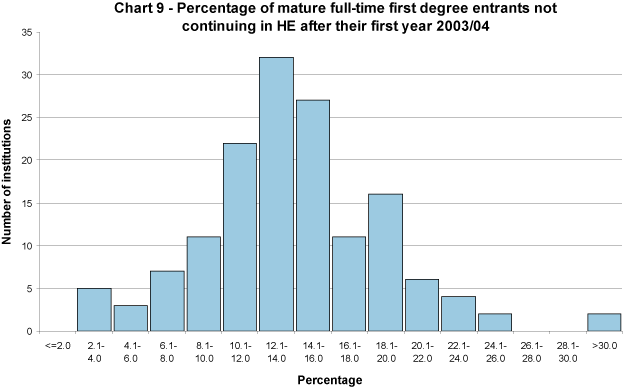
Sourced from Table T3a of the Performance Indicators.
Table T3d shows the proportion of full-time other undergraduate entrants to an institution that continue in higher education beyond the first year. These proportions are provided separately for young and mature full-time other undergraduate entrants to higher education.
In general, a very similar proportion of mature and young full-time other undergraduate entrants do not continue in higher education after their first year, although it's slightly higher for young entrants this year. For entrants in 2003/04, the UK non-continuation rate is 15.6% (16.1% in 2001/02) for mature entrants compared with 20.0% (17.7% in 2002/03) for young entrants.
Table J shows the non-continuation rates for the countries of the UK, for young and mature full-time other undergraduate entrants. Charts 10 and 11 illustrate the spread of values between institutions, again for young and mature full-time other undergraduate entrants.
Table J - Percentage of full-time other undergraduate entrants not continuing in HE after their first year
| Young | Mature | ||||||
|---|---|---|---|---|---|---|---|
| 2001/02 | 2002/03 | 2003/04 | 2001/02 | 2002/03 | 2003/04 | ||
| UK | 18.7 | 17.7 | 20.0 | 17.1 | 16.1 | 15.6 | |
| England | 16.3 | 16.1 | 17.5 | 15.8 | 14.5 | 14.3 | |
| Wales | 21.6 | 22.0 | 18.2 | 25.1 | 23.1 | 23.0 | |
| Scotland | 32.6 | 25.7 | 36.0 | 23.5 | 25.2 | 23.0 | |
| Northern Ireland | 18.7 | 20.6 | 25.2 | 8.6 | 12.1 | 13.7 | |
Sourced from Table T3d of the Performance Indicators.
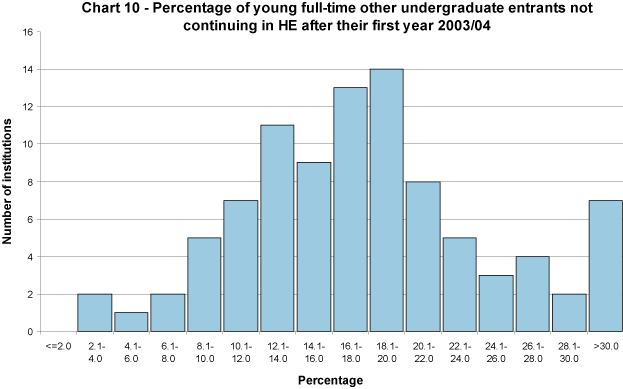
Sourced from Table T3d of the Performance Indicators.
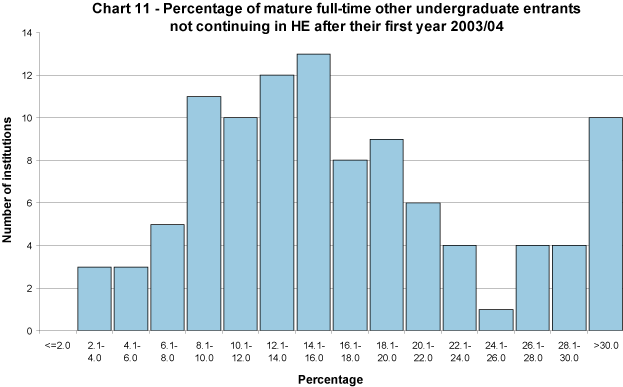
Sourced from Table T3d of the Performance Indicators.
Return after a year out
Further information is provided in Table T4a about full-time first degree entrants who started at university or college in 2002/03, but were not in higher education in 2003/04. Nationally, 12.3% (13.6% in 2001/02) of young full-time first degree students and 11.0% (11.1% in 2001/02) of mature full-time first degree students in this category returned to their original institution in 2004/05, with a further 12.5% (13.0% in 2001/02) of young full-time first degree students and 5.1% (5.5% in 2001/02) of mature full-time first degree students transferring to another institution.
Similar figures are provided in Table T4b for full-time other undergraduate entrants who started at university or college in 2002/03, but were not in higher education in 2003/04. Nationally, 8.6% (8.4% in 2001/02) of young full-time other undergraduate students and 11.6% (12.6% in 2001/02) of mature full-time other undergraduate students in this category returned to their original institution in 2004/05, with a further 5.2% (6.0% in 2001/02) of young full-time other undergraduate students and 4.6% (3.6% in 2001/02) of mature full-time other undergraduate students transferring to another institution.
Projected outcomes
The projected outcomes in Table T5 summarise the pattern of movements of students at institutions between 2003/04 and 2004/05. They give the outcomes that would be expected from starters at the institution in 2003/04 if these progression patterns were to remain unchanged over the next few years.
The sector averages for the UK and its constituent countries are obtained by taking a (weighted) average of all the relevant institutional values. They show that 77.1% of full-time first degree students starting at an institution in 2003/04 are expected to qualify from that institution with a degree (77.4% in 2002/03) and 14.9% are expected to get no qualification (14.4% in 2002/03). A further 5.7% are expected to transfer to another institution (6.1% in 2002/03). The projected percentage of students who leave before gaining any award, and who neither return to study nor transfer to another institution, is less than 25% for the majority of institutions. Tables K and L give a summary across the countries of the United Kingdom.
Table K - Projected outcomes – percentage of full-time first degree starters expected to gain a degree (sector averages)
| Obtain degree | |||||
|---|---|---|---|---|---|
| 1999/2000 | 2000/01 | 2001/02 | 2002/03 | 2003/04 | |
| UK | 77.3 | 77.8 | 77.9 | 77.4 | 77.1 |
| England | 77.4 | 78.1 | 78.4 | 78.1 | 77.7 |
| Wales | 77.3 | 78.7 | 78.2 | 75.2 | 76.8 |
| Scotland | 74.3 | 73.6 | 73.0 | 72.1 | 73.3 |
| Northern Ireland | 85.2 | 83.3 | 81.9 | 80.8 | 75.9 |
Sourced from Table T5 of the Performance Indicators.
Table L - Projected outcomes – percentage of full-time first degree starters expected to neither obtain an award nor transfer (sector averages)
| No award nor transfer | |||||
|---|---|---|---|---|---|
| 1999/2000 | 2000/01 | 2001/02 | 2002/03 | 2003/04 | |
| UK | 15.9 | 15.0 | 14.1 | 14.4 | 14.9 |
| England | 15.9 | 15.0 | 13.8 | 13.9 | 14.4 |
| Wales | 15.0 | 13.8 | 14.7 | 16.2 | 15.4 |
| Scotland | 17.6 | 16.5 | 16.3 | 17.6 | 17.5 |
| Northern Ireland | 11.1 | 11.8 | 12.2 | 14.5 | 19.1 |
Sourced from Table T5 of the Performance Indicators.
Chart 12 shows the spread of values across institutions for the percentage of starters projected to neither obtain an award nor transfer to another institution.
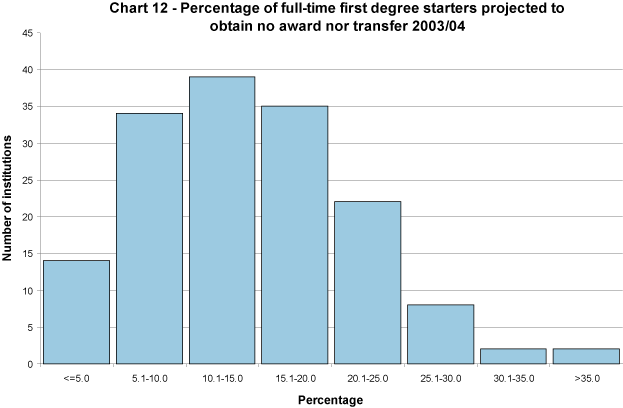
Sourced from Table T5 of the Performance Indicators.
Module completion rates
Table T6 looks at module completion rates for part-time students. The provision of this information is dependent on how student data are returned to HESA. Only institutions in Wales are required to return a module record to HESA, therefore this table only includes data on these institutions. The table shows what percentage of modules, undertaken by part-time students, are successfully completed and some statistics to put this percentage into context. For 2004/05, 65.0% (63.4% in 2003/04) of the relevant modules had results provided, and in 89.5% (90.0% in 2003/04) of cases the module was passed. On average each part-time student undertook 2.4 modules (2.4 in 2003/04), and each module was worth an average 13.6% (14.3% in 2003/04) full-time equivalent.
Research indicators
Research indicators, which are given in Table R1, are different in kind to other indicators, in that they do not wholly relate to the student population. They measure research output (as shown by the number of PhDs awarded and the amount of research grants or contracts for which expenditure has been incurred) against resource inputs (namely, academic staff costs and the funding councils’ allocations for research).
These indicators do not measure research quality as the Research Assessment Exercise does that. The results from the 2001 RAE exercise are available here.
Research indicators are all standardised to a value of 1 and take account of the differing ratios of output to input in different cost centres. A value of 1 for an indicator shows that the institution is producing the same as the rest of the sector, relative to its input. A value below 1 shows it is producing less than the sector, and a value greater than 1 shows that it is producing more than the sector, again relative to its input.
All four research indicators show similar patterns to those from last year, with the majority of institutions having values below 2. The indicators using academic staff costs as the input are less variable between the years than the indicators which use funding councils’ research allocation, in part because the amount of funding for some institutions is very small relative to that for the large research universities.
Employment indicator
The employment indicators are based on the responses to the Destination of Leavers from Higher Education (DLHE) survey, which replaced the First Destinations survey three years ago. In 2004/05, the response rate to the survey for those graduating from full-time courses with a first degree was 81.8% (83.6% in 2003/04). Table M shows comparative results by academic year.
Table M - Response rates of full-time first degree qualifiers
| 2000/01 | 2001/02 | 2002/03 | 2003/04 | 2004/05 | |
|---|---|---|---|---|---|
| Eligible population | 208655 | 208895 | 213715 | 219810 | 226110 |
| Respondents | 175435 | 175080 | 177745 | 183675 | 184970 |
| Response rate | 84.1% | 83.8% | 83.2% | 83.6% | 81.8% |
Sourced from Table E1 of the Performance Indicators.
The table below shows the employment outcomes of full-time first degree graduates by academic year, based on all respondents to the survey. The proportion of graduates who were in employment (excluding those in employment and further study) six months after leaving was 62.8% (62.7% in 2003/04), a further 8.1% (8.6% in 2003/04) were in employment and further study and 14.9% (15.0% in 2003/04) were in further study only.
Table N - Employment outcomes of full-time first degree qualifiers
| 2002/03 | 2003/04 | 2004/05 | |
|---|---|---|---|
| Employment | 62.9% | 62.7% | 62.8% |
| Employment and further study | 7.9% | 8.6% | 8.1% |
| Further study only | 14.8% | 15.0% | 14.9% |
| Assumed to be unemployed | 7.0% | 6.4% | 6.5% |
| Not available for employment | 5.2% | 5.0% | 4.9% |
| Other | 1.0% | 1.0% | 1.1% |
| Question not answered | 1.2% | 1.4% | 1.8% |
The percentages given in table N differ from the employment indicator shown in table E1 which is based on all respondents to the survey who are classed as working or studying or as unemployed and seeking work, see employment definitions for details. Chart 13 shows the spread of the employment indicator across institutions.
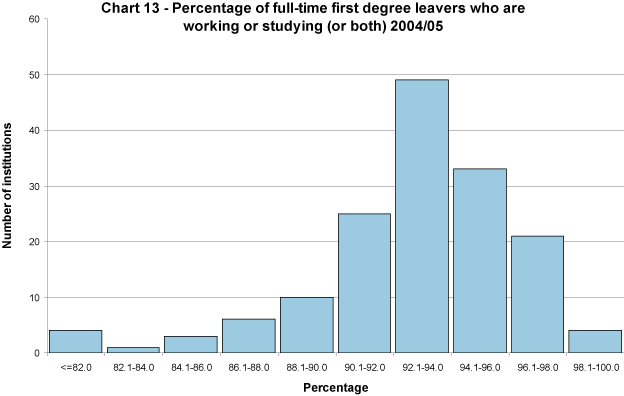
Sourced from Table E1 of the Performance Indicators.
Enquiries
- Press: Call 01242 211120 or email [email protected].
- General enquiries should be sent to [email protected].
- Enquiries regarding the UK Performance Indicators Steering Group (UKPISG) should be directed to the HEFCE Press Office on 0117 931 7363
- This work is licensed under a Creative Commons Attribution 4.0 International License.

